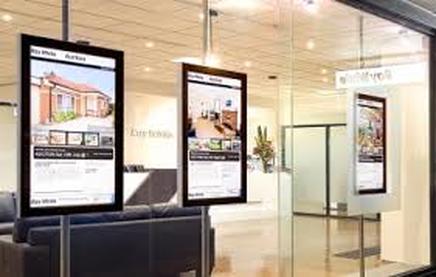Digital Signage

Digital Signage is a form of electronic display that shows television programming, menus, information, advertising and other messages. Digital Signs (such as LCD, LED, plasma displays or projected images) can be found in public and private environments, such as retail stores, hotels, restaurants and corporate buildings.
Digital Signage Displays are most usually controlled by personal computers or servers by way of proprietary software programs, avoiding any large capital outlays for the controller equipment.
Advertising using Digital Signage is a form of out-of-home advertising in which video content, advertisements and messages are displayed on Digital Signs with a common goal of delivering targeted messages to specific locations at specific times. This is often called "digital out of home" or abbreviated as DOOH.[1]
The market sees Digital Signage as more beneficial compared to static signage because content that updates frequently can be digitally updated, saving the cost of printing. Digital Signage also has the ability to be interactive with imbedded touch screens, movement detection and image capture devices.
Digital Signage is used for many different purposes and there is no definitive list. However, below are some of the most common applications of Digital Signage:
Digital Signage relies on a variety of hardware to deliver the content. The components of a typical Digital Signage installation include one or more display screens, one or more media players and a content management server. Sometimes two or more of these components are present in a single device, but typically there is a display screen, a media player and a content management server that is connected to the media player over a network. One content management server may support multiple media players and one media player may support multiple screens. Stand-alone Digital Signage devices combine all three functions in one device.
Call us today 920-684-3393
Digital Signage Displays are most usually controlled by personal computers or servers by way of proprietary software programs, avoiding any large capital outlays for the controller equipment.
Advertising using Digital Signage is a form of out-of-home advertising in which video content, advertisements and messages are displayed on Digital Signs with a common goal of delivering targeted messages to specific locations at specific times. This is often called "digital out of home" or abbreviated as DOOH.[1]
The market sees Digital Signage as more beneficial compared to static signage because content that updates frequently can be digitally updated, saving the cost of printing. Digital Signage also has the ability to be interactive with imbedded touch screens, movement detection and image capture devices.
Digital Signage is used for many different purposes and there is no definitive list. However, below are some of the most common applications of Digital Signage:
- Public Information – news, weather and local (location specific) information, such as fire exits and traveler information
- Internal Information – corporate messages, health & safety, news, etc.
- Menu Information – pricing, photos, ingredients and other food information including nutritional facts
- Advertising – either related to the location the signage is in or just using the audience reach of the screens for general advertising
- Brand Building – in-store digital signage to promote the brand and build a brand identity
- Influencing Customer Behavior – directing customers to different areas, increasing the dwell time on the store premises
- Enhancing Customer Experience – applications include the reduction of perceived wait time in restaurant waiting areas, bank queues, etc., as well as, recipe demonstrations in food stores
- Enhancing the Environment – with interactive screens (in the floor for example) or with dynamic wayfinding
Digital Signage relies on a variety of hardware to deliver the content. The components of a typical Digital Signage installation include one or more display screens, one or more media players and a content management server. Sometimes two or more of these components are present in a single device, but typically there is a display screen, a media player and a content management server that is connected to the media player over a network. One content management server may support multiple media players and one media player may support multiple screens. Stand-alone Digital Signage devices combine all three functions in one device.
Call us today 920-684-3393


